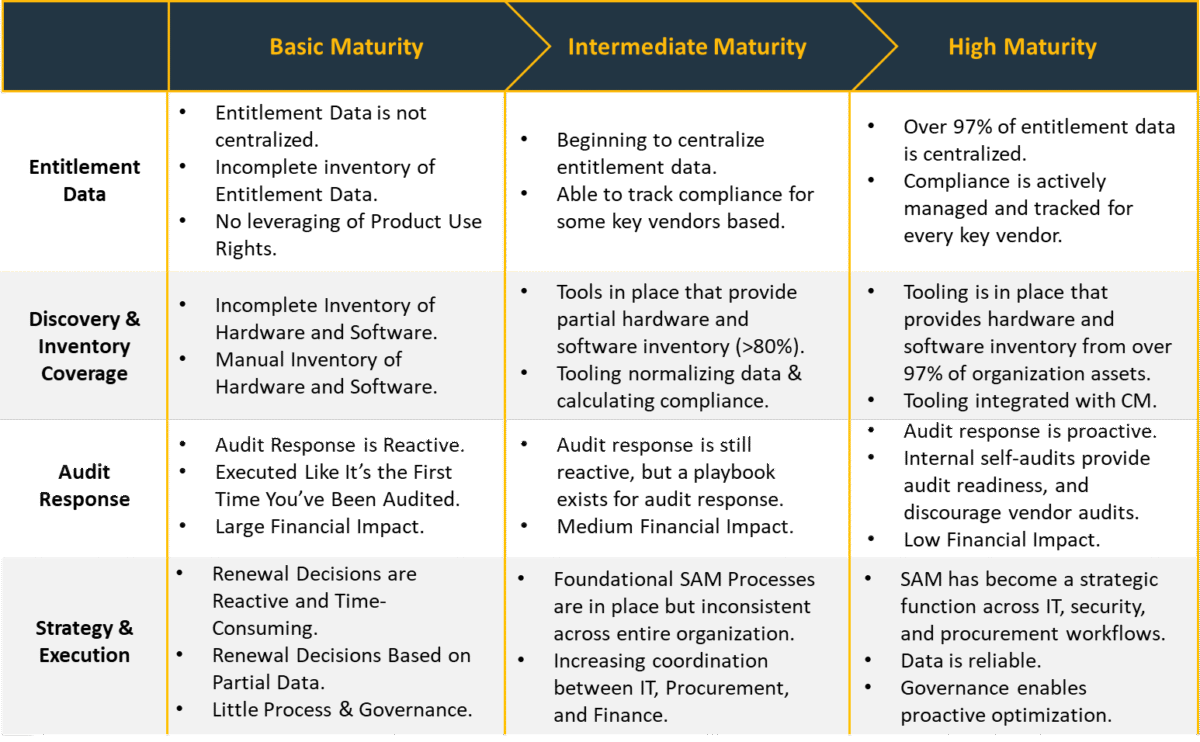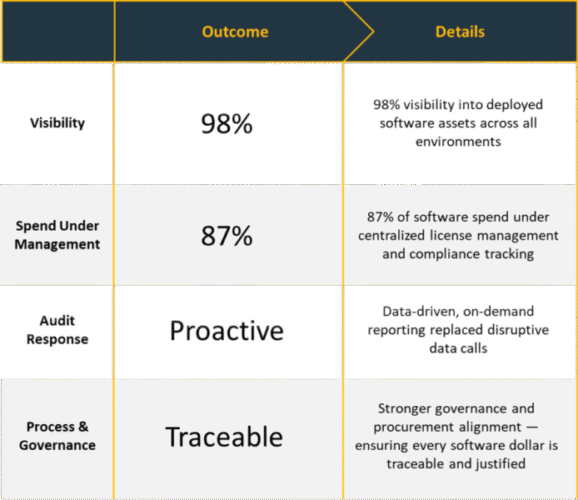Resources
Back to AllFederal Agency SAM Transformation with Flexera

The Starting Point: A Federal Agency’s SAM Struggles
Many federal agency SAM transformation efforts fall short, but with the right approach, these initiatives can drive real visibility, cost savings, and audit readiness.
Like many public sector organizations, this U.S. Federal agency managed a vast and diverse IT ecosystem with thousands of endpoints, multiple security enclaves, and hundreds of software publishers. However, their Software Asset Management (SAM) capabilities had not evolved alongside the complexity of their environment. Software inventories were tracked in spreadsheets, procurement relied on ad hoc data calls, and audit readiness meant mobilizing staff in a reactive scramble.
With increasing pressure to control software costs, meet audit requirements, and support agency-wide digital transformation goals, leadership recognized the need for a complete overhaul. They turned to InSequence Inc. to achieve federal agency SAM transformation by designing and implementing a modern, scalable SAM solution tailored to their mission, budgetary realities, and security constraints.
Challenges: Fragmented SAM and Rising Risk
The agency’s pre-engagement SAM posture was characterized by risk, inefficiency, and fragmentation:
- License data lived in silos — procurement teams, system owners, and CORs each kept their own version of the truth, with no centralized repository or system of record.
- Discovery coverage was incomplete and duplicative — across six SCCM instances, multiple vCenters, cloud tenants, and air-gapped network enclaves, no unified view of deployed software existed.
- Audits were disruptive — vendor and internal audits often required manual data calls and last-minute license reconciliations, diverting resources from mission priorities.
- Software procurement missed the full picture — business units procured software with little requirements gathering, often renewing what was purchased the previous contract.
- No visibility into usage or deployment trends — preventing optimization, license harvesting, or accountability at the business unit level.
In short, the agency was flying blind — unable to confidently answer fundamental questions about what software they owned, what was deployed, who was using it, or how it aligned with mission needs.
SAM Maturity Model
The following diagram illustrates InSequence’s SAM Maturity Model:

How a Federal Agency Transformed SAM
The Agency engaged a team with dedicated SAM knowledge and a proven approach achieve federal agency SAM transformation. InSequence worked side by side with key stakeholders to design and implement a multi-phase transformation initiative, balancing strategic governance, advanced tooling, and operational enablement.
Phase 1: Assessing SAM Health and Building the Roadmap
InSequence began with a comprehensive SAM health assessment, analyzing:
- Governance policies
- Procurement workflows
- Inventory completeness
- Contract ingestion practices
- Audit readiness posture
The findings shaped a phased roadmap, prioritizing high-risk areas and identifying quick wins.
Phase 2: Deploying Flexera as the SAM System of Record
In complex environments, successful efforts must use powerful tooling and dedicated experts to transform SAM. The agency elected to Transformed SAM with InSequence and Flexera.
The agency selected FlexNet Manager Suite (FNMS) as its core SAM platform. InSequence led the deployment, configuration, and operationalization of the tool, establishing it as the authoritative license management system.
Phase 3: Aligning SAM with Procurement Processes
InSequence integrated FNMS with the agency’s central procurement repository, enabling an automated intake workflow for software purchases. Each contract now moves through a consistent approval and ingestion process — ensuring entitlements are captured and managed centrally from the start.
Phase 4: Unified Inventory Across Enclaves and Tools
To build a unified software inventory, InSequence:
- Integrated feeds from Tanium, 6 SCCM implementations, 16 VMware vCenters, VMware Horizon, 2 M365 tenants, and Azure.
- Deployed the Flexera FlexNet Inventory Agent to 4,500+ servers, enabling specialized software recognition (Oracle, IBM, Microsoft) and visibility into Hyper-V VM/host relationships
- Built logic to eliminate duplicates across tools and normalize hardware/software attributes
- Executed a project to decommission ILMT and migrate IBM reporting requirements to FNMS
Result: 98% asset visibility across all environments, with gaps clearly documented and remediation plans created.
Phase 5: Tiered Vendor Management for Audit Readiness
InSequence worked with agency leadership to categorize software publishers into tiers based on:
- Strategic importance
- Software spend
- Deployment breadth
- Vendor audit risk
This approach enabled the agency to prioritize Tier 1 vendors (e.g., Microsoft, Oracle, IBM) for building Effective License Positions (ELPs), achieving early wins and audit preparedness where it mattered most.
Result: 87% of the agency’s software spend is now actively managed in FlexNet Manager, with validated ELPs for top-tier vendors.
Phase 6: Mapping Licenses to Business Units for Accountability
InSequence developed business rules to tag devices with business unit ownership, aligning licenses, contracts, and usage data with organizational cost centers. This laid the foundation for future chargeback capabilities while immediately enabling stakeholder-specific visibility and accountability.
Phase 7: Identifying Untracked Software with SME Workflows
To address software missed by automated discovery, InSequence created repeatable data call workflows that:
- Enlist software SMEs during the ELP process
- Provide SME access to FNMS for reporting usage
- Schedule periodic reviews and updates to maintain currency
Phase 8: Harvesting and Optimizing Software Licenses
- InSequence stood up a software license harvesting framework to reclaim unused or underutilized licenses. Using FNMS usage data and license metrics, they:Flagged candidates for harvesting
- Identified right-sizing opportunities
- Helped reallocate licenses within the agency before new purchases were made
Phase 9: Training Stakeholders for Long-Term SAM Success
Finally, InSequence delivered tailored training sessions to:
- System owners and infrastructure teams – on the impact of architecture decisions on licensing
- Software SMEs – on usage tracking, FNMS reporting, and discovery data
- CORs and procurement teams– on facilitating requirements gathering using the data in FNMS
Result: A cultural shift where infrastructure teams proactively consult the SAM team before changes, and CORs consistently use FNMS data in procurement decisions.
The Results: Compliance, Visibility, and Cost Savings
The agency proved the value of federal agency SAM transformation and saw dramatic improvements across compliance, cost efficiency, and operational maturity:
- 98% visibility into deployed software assets across all environments
- 87% of software spend under centralized license management and compliance tracking
- Streamlined audit response — data-driven, on-demand reporting replaced disruptive data calls
- Active software license harvesting, with cost savings and purchase deferrals already realized
- End-to-end visibility and traceability of software from procurement to deployment and usage
- Stronger governance and procurement alignment — ensuring every software dollar is traceable and justified
Why Federal Agency SAM Transformation Matters
In the federal landscape, where audit readiness, fiscal responsibility, and mission alignment are critical, a modern SAM capability is no longer optional — it’s essential. This engagement shows how agencies can move beyond reactive license management to proactive, accountable, and value-driven software governance.
The key was not just technology, but expert-led transformation. InSequence combined Flexera’s capabilities with practical governance models, training, and workflows tailored to the agency’s structure. The result was not just compliance — it was clarity, control, and confidence.
Key Takeaways
- Tools alone don’t deliver SAM success — pairing platforms like Flexera with experienced partners like InSequence is the formula for sustainable impact.
- Visibility drives decisions — 98% asset coverage enabled license reclamation, contract alignment, and risk mitigation.
- Tiered prioritization works — targeting Tier 1 vendors first accelerated results and ensured audit readiness where risk was highest.
- Training fosters sustainability — when system owners and CORs understand licensing, they engage earlier and smarter.
- Government can lead in SAM maturity — this agency set a new standard for public sector software governance.
Real Outcomes
The customer achieved quantifiable results proving the value of effective SAM. The following table outlines the key outcomes:

Why InSequence: Federal SAM Experts Who Deliver Results
InSequence brings deep expertise in Software Asset Management, combining strategic advisory services with hands-on implementation of leading platforms like Flexera. Our team doesn’t just deploy tools — we transform processes, align stakeholders, and embed best practices tailored to complex environments like the federal government. We prioritize operational sustainability by establishing governance, driving adoption, and enabling proactive license management. With InSequence, agencies move from manual chaos to confident control.
Learn about InSequence Licensing Experts:
https://www.insequenceinc.com/what-we-do/it-asset-management/software-license-experts/
Learn about InSequence SAM Managed Services:
https://www.insequenceinc.com/services/sam365/
Schedule a Discovery Consult
https://www.insequenceinc.com/setup-discussion-cta/


